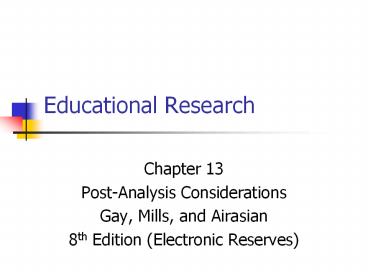Educational Research - PowerPoint PPT Presentation
1 / 14
Title:
Educational Research
Description:
Educational Research Chapter 13 Post-Analysis Considerations Gay, Mills, and Airasian 8th Edition (Electronic Reserves) Topics Discussed in this Chapter Verification ... – PowerPoint PPT presentation
Number of Views:118
Avg rating:3.0/5.0
Title: Educational Research
1
Educational Research
- Chapter 13
- Post-Analysis Considerations
- Gay, Mills, and Airasian
- 8th Edition (Electronic Reserves)
2
Topics Discussed in this Chapter
- Verification and storage of data
- Checking, organizing, and evaluating data
- Interpretation of results
- Hypothesized and unhypothesized results
- Statistical issues
- Methodological issues
- Statistical and practical significance
- Replication
3
Verifying and Storing Data
- Three issues
- Checking data
- Organizing data
- Evaluating the research conclusions
- Checking data for accuracy
- Check the original data
- Check the coded data against the initial uncoded
data - Electronic data
- Print the data sets and check them
- Check the output carefully
Objective 1.1
4
Verifying and Storing Data
- Organizing data
- Label the data
- Dates
- Important details related to the data itself and
the study - Store the data
- Multiple copies
- Multiple sites
Objective 1.2
5
Verifying and Storing Data
- Evaluate the research conclusion(s)
- Check the accuracy of the computations
- Check the reasonableness of the results
Objective 1.3
6
Interpreting the Results
- Interpretations are made in light of
- the purpose of the study,
- the original research hypotheses, and
- the findings of other related studies.
- Hypothesized results
- Results are interpreted relative to their support
or lack of support of the research hypotheses
Objectives 2.1 3.1
7
Interpreting Results
- Hypothesized results (continued)
- Supported hypotheses
- Probabilistic nature of the decision
- Easily interpreted given the control and
manipulation used in the research design - Non-supported hypotheses
- Probabilistic nature of the decision
- Possible importance of knowing what doesnt work
- Potential methodological problems
Objectives 2.1 3.1
8
Interpreting Results
- Unhypothesized results
- Results that appear during the study
- Must be interpreted with great care
- Researchers base their studies on ideas related
to what will happen, not what is happening - Possible importance to and influence on later
studies
Objective 4.1 4.2
9
Interpreting Results
- Statistical influences
- The sample must be representative of the
population - The assumptions of the specific statistical tests
of significance must be met
Objective 5.1
10
Interpreting Results
- Three methodological influences
- Measurement error large amounts of error hamper
the ability to find statistically significant
results - Statistical power
- The probability of avoiding a Type II error
(failure to reject a false null hypothesis
something is there but you say there isnt)
Objectives 5.2 6.1
11
Interpreting Results
- Three methodological factors (cont.)
- Statistical power (cont.)
- Three influential factors
- Sample size the larger the sample the greater
the power - Significance levels
- Increasing alpha (e.g., .01, .05, .10) increases
power - If you say that there is a 5 chance that the
differences are due to chance (null) then you are
more likely to accept a false null hypothesis
than if you set the value at a 10 chance.
Objectives 5.2 6.2
12
Interpreting Results
- Three methodological factors (cont.)
- Statistical power (cont.)
- Effect size
- Larger effect sizes increase power
- Effect sizes can be estimated from prior studies,
estimated by minimal levels below which the
results are deemed unimportant, and agreed upon
levels of small (.20), moderate (.50), and large
(.80).
Objectives 5.2 6.2
13
Interpreting Results
- Statistical and practical significance
- Statistical significance relates to the tests of
significance being used - Practical significance relates to the usefulness
of the results - Statistical and practical significance are not
necessarily the same - Statistical significance depends on sample size
- Studies with large samples can be significant but
of little value
Objective 5.3
14
Interpreting Results
- Replication
- Replication involves repeating the study
- Different subjects
- Different context
- Different times
- Extremely important when
- an unusual or new result is found, or
- the results have high levels of practical
significance.
Objective 7.1































